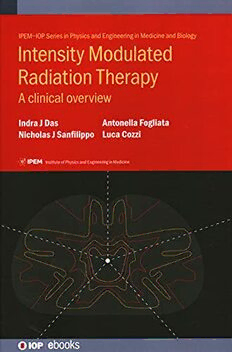Table Of ContentIntensity Modulated Radiation
Therapy
A clinical overview
IPEM–IOP Series in Physics and Engineering in Medicine and Biology
Editorial Advisory Board Members
Frank Verhaegen Kwan Hoong Ng
Maastro Clinic, the Netherlands University of Malaya, Malaysia
Carmel Caruana John Hossack
University of Malta, Malta University of Virginia, USA
Penelope Allisy-Roberts Tingting Zhu
formerly of BIPM, Sèvres, France University of Oxford, UK
Rory Cooper Dennis Schaart
University of Pittsburgh, USA TU Delft, the Netherlands
Alicia El Haj Indra J Das
University of Birmingham, UK NorthwesternUniversityFeinbergSchool
of Medicine, USA
About the Series
Series in Physics and Engineering in Medicine and Biology will allow IPEM to
enhance its mission to ‘advance physics and engineering applied to medicine and
biology for the public good.’
Focusing on key areas including, but not limited to:
(cid:129) clinical engineering
(cid:129) diagnostic radiology
(cid:129) informatics and computing
(cid:129) magnetic resonance imaging
(cid:129) nuclear medicine
(cid:129) physiological measurement
(cid:129) radiation protection
(cid:129) radiotherapy
(cid:129) rehabilitation engineering
(cid:129) ultrasound and non-ionising radiation.
A number of IPEM–IOP titles are published as part of the EUTEMPE Network
Series for Medical Physics Experts.
Intensity Modulated Radiation
Therapy
A clinical overview
Indra J Das
Department of Radiation Oncology, Northwestern University Feinberg School of
Medicine, Chicago, USA
Nicholas J Sanfilippo
Department of Radiation Oncology, Weill Cornell Medical College, New York, USA
Antonella Fogliata
Department of Radiotherapy, Humanitas Clinical and Research Center IRCCS,
Milan-Rozzano, Italy
Luca Cozzi
Department of Radiotherapy, Humanitas Clinical and Research Center IRCCS,
Milan-Rozzano, Italy
and
Humanitas University, Milan-Rozzano, Italy
IOP Publishing, Bristol, UK
ªIOPPublishingLtd2020
Allrightsreserved.Nopartofthispublicationmaybereproduced,storedinaretrievalsystem
ortransmittedinanyformorbyanymeans,electronic,mechanical,photocopying,recording
orotherwise,withoutthepriorpermissionofthepublisher,orasexpresslypermittedbylawor
undertermsagreedwiththeappropriaterightsorganization.Multiplecopyingispermittedin
accordancewiththetermsoflicencesissuedbytheCopyrightLicensingAgency,theCopyright
ClearanceCentreandotherreproductionrightsorganizations.
CertainimagesinthispublicationhavebeenobtainedbytheauthorsfromtheWikipedia/
Wikimediawebsite,wheretheyweremadeavailableunderaCreativeCommonslicenceorstated
tobeinthepublicdomain.Pleaseseeindividualfigurecaptionsinthispublicationfordetails.To
theextentthatthelawallows,IOPPublishingdisclaimanyliabilitythatanypersonmaysufferasa
resultofaccessing,usingorforwardingtheimages.Anyreuserightsshouldbecheckedand
permissionshouldbesoughtifnecessaryfromWikipedia/Wikimediaand/orthecopyrightowner
(asappropriate)beforeusingorforwardingtheimages.
PermissiontomakeuseofIOPPublishingcontentotherthanassetoutabovemaybesought
[email protected].
IndraJDas,NicholasJSanfilippo,AntonellaFogliataandLucaCozzihaveassertedtheirrightto
beidentifiedastheauthorsofthisworkinaccordancewithsections77and78oftheCopyright,
DesignsandPatentsAct1988.
Multimediacontentisavailableforthisbookfromhttp://iopscience.iop.org/book/978-0-7503-1335-3.
ISBN 978-0-7503-1335-3(ebook)
ISBN 978-0-7503-1336-0(print)
ISBN 978-0-7503-1769-6(myPrint)
ISBN 978-0-7503-1337-7(mobi)
DOI 10.1088/978-0-7503-1335-3
Version:20201201
IOPebooks
BritishLibraryCataloguing-in-PublicationData:Acataloguerecordforthisbookisavailable
fromtheBritishLibrary.
PublishedbyIOPPublishing,whollyownedbyTheInstituteofPhysics,London
IOPPublishing,TempleCircus,TempleWay,Bristol,BS16HG,UK
USOffice:IOPPublishing,Inc.,190NorthIndependenceMallWest,Suite601,Philadelphia,
PA19106,USA
Dedicated to my late grandfather Jagdev Das, who guided me to learning and
education early in my childhood.
&
MyloveandgratitudetomywifeSununtaCDas,sonAvanindraCDas,anddaughter
Anita C Das for their constant support of my pursuits.
—Indra J Das
Idedicatethisbooktomyfather,LouisJSanfilippo,MD,whoinspiredmetopursuea
careerinradiationoncologyandalwaysgavemethebestadvice.Ithasbeenanhonor
to follow in his footsteps. Also, to my mother, Ismene Sanfilippo, who has been a
constant source of strength in my life. I owe both of them everything.
—Nicholas J Sanfilippo
Dedicated to my parents, who instilled in me the joy of finding the beauty in working
for the care of the human beings, and thanks to Professor Jacques Bernier, who I
workedwithandwhoencouragedmetoapproachIMRTinthelate90s.Thankstomy
daughtersandsonswhosupportedme,andtomyhusband,whoencouragedmeonthis
long journey.
—Antonella Fogliata
ThankstoAntonellawhoassistedmytransformationfromparticletomedicalphysics!
Withoutherbrilliantbrainnothingwouldhavebeenpossible!Thankstoourkids.They
hadtolearnhowtomanagewiththeirparentstoofrequentlyatthehospital(weeven
breast-fed the first during a linac commissioning in the console room!) or travelling
aroundtheworld.Ihopetheywilldevelopsomeofthepassionweputintoourjobsand
will gain the same satisfaction from their professional lives as we did.
—Luca Cozzi
Contents
Preface xiii
Author biographies xiv
Acronyms xvi
1 Introduction 1-1
References 1-4
2 Beam modulation 2-1
2.1 Forward planning 2-2
2.2 Paradigm shift 2-2
2.3 Simulated annealing 2-3
References 2-6
3 Definitions and terminology 3-1
3.1 Pixel 3-1
3.2 Voxel 3-3
3.3 Bixel (beamlet) 3-3
3.4 Intensity level 3-3
3.5 Segment 3-5
3.6 Concept of dose painting 3-5
References 3-6
4 IMRT devices 4-1
4.1 Intensity modulation filter/compensator 4-2
4.2 Dynamic Jaw 4-3
4.3 MLC based 4-4
4.4 Direct aperture optimization (DAO) 4-5
4.5 Systems for IMRT 4-5
4.5.1 Peacock-MIMiC 4-5
4.5.2 Tomotherapy 4-6
References 4-9
vii
IntensityModulatedRadiationTherapy
5 IMRT, IMAT and VMAT 5-1
5.1 IMRT 5-1
5.1.1 Step and shoot IMRT 5-1
5.1.2 Dynamic delivery IMRT 5-3
5.2 IMAT 5-5
5.3 Volumetric, modulated arc therapy, VMAT 5-6
5.4 Outlook 5-10
References 5-10
6 Intensity modulated planning process 6-1
6.1 IMRT planning process 6-1
6.2 Imaging 6-1
6.3 Target volume 6-2
6.4 DVH constraints 6-3
6.5 Inverse planning 6-5
6.6 MLC sequencing 6-6
6.7 Transfer and treatment sequencing 6-8
6.8 Phantom plan 6-9
6.9 IMRT PSQA 6-9
6.10 Treatment verification 6-9
6.11 Record and verification 6-10
References 6-11
7 Contouring 7-1
7.1 Contouring for intensity modulation inverse planning 7-1
7.2 Margins 7-9
7.3 Motion and contouring 7-10
7.4 Auto-segmentation 7-17
7.4.1 First generation of auto-segmentation methods (model-based) 7-18
7.4.2 Second generation of auto-segmentation methods 7-18
7.4.3 Third generation of auto-segmentation 7-18
methods (atlas-based)
7.4.4 Fourth generation of auto-segmentation 7-19
methods (deep learning)
References 7-22
viii
IntensityModulatedRadiationTherapy
8 Treatment planning 8-1
8.1 Beam (and arc) geometry 8-1
8.2 The collimator rotation 8-4
8.3 Non-coplanarity 8-7
8.4 Flattened and unflattened beams 8-9
8.5 Modulation degrees and delivery accuracy 8-10
8.6 The feathering: large field splitting and multi-isocentric setup 8-15
8.6.1 Overlap in the lateral direction (large volumes) 8-16
8.6.2 Overlap in the longitudinal direction (long volumes) 8-16
8.7 Artifact handling 8-19
8.8 The interplay effect 8-22
8.9 The neutron production and the whole body dose: beam quality 8-24
8.10 Conclusions on treatment planning 8-26
References 8-27
9 Optimization 9-1
9.1 The inverse planning concept 9-1
9.2 The goals and the cost function 9-3
9.3 The optimization objectives 9-4
9.4 The optimization algorithms 9-7
9.4.1 The deterministic algorithms 9-7
9.4.2 The stochastic algorithms 9-9
9.5 The direct aperture optimization 9-10
9.6 The biological optimization 9-11
9.6.1 The radiobiological models for TCP, NTCP, EUD 9-12
9.7 Benefit and deficiencies in biological optimization 9-15
9.8 Robust optimization 9-16
References 9-18
10 Dose calculation 10-1
10.1 Required accuracy in dose calculation 10-1
10.2 Dose calculation algorithms and classification 10-3
10.2.1 The empirical models 10-4
10.2.2 The semi-empirical, correction-based algorithms 10-5
10.2.3 The kernel-based algorithms: pencil beam, AAA, 10-6
collapsed cone
ix

